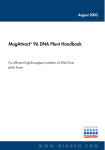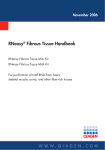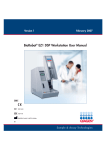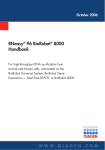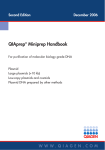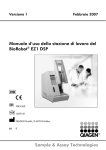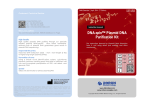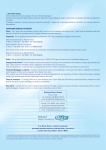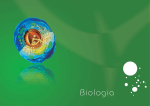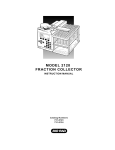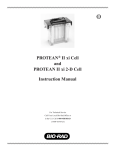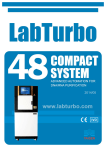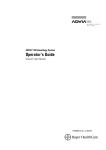Download EZ1 DNA Handbook - Projects at NFSTC.org
Transcript
Second Edition February 2004 EZ1 DNA Handbook EZ1 DNA Blood 200 µl Kit EZ1 DNA Blood 350 µl Kit EZ1 DNA Tissue Kit For automated purification of DNA from blood, tissue, and other samples using the BioRobot® EZ1 workstation W W W. Q I A G E N . C O M Trademarks: QIAGEN®, BioRobot® (QIAGEN Group); Eppendorf® (Eppendorf-Netheler-Hinz GmbH). QIAGEN Robotic Systems are not available in all countries; please inquire. The BioRobot EZ1 and EZ1 Kits are intended as general-purpose devices. No claim or representation is intended for their use to identify any specific organism or for a specific clinical use (diagnostic, prognostic, therapeutic, or blood banking). It is the user’s responsibility to validate the performance of the BioRobot EZ1 and EZ1 Kits for any particular use, since their performance characteristics have not been validated for any specific organism. The BioRobot EZ1 and EZ1 Kits may be used in clinical diagnostic laboratory systems after the laboratory has validated their complete system as required by CLIA '88 regulations in the U.S. or equivalents in other countries. © 2004 QIAGEN, all rights reserved. 2 EZ1 DNA Handbook 02/2004 Contents Kit Contents 4 Storage 4 Quality Control 4 Product Use Limitations 5 Product Warranty and Satisfaction Guarantee 5 Technical Assistance 5 Safety Information 6 Introduction 7 Principle and procedure 7 Working with the BioRobot EZ1 7 Important Notes Starting material 13 13 Storage of blood samples 13 Yield of purified DNA 13 Precipitate in reagent cartridge 13 Lysis with proteinase K 14 Quantification of DNA 14 Protocols Purification of Genomic DNA from Whole Blood 15 Purification of Genomic DNA from Tissue 17 Troubleshooting Guide 19 Appendix: Storage, Quantification, and Determination of Purity of DNA 20 Ordering Information 21 QIAGEN Distributors 23 EZ1 DNA Handbook 02/2004 3 Kit Contents EZ1 DNA Kits* Catalog no. Preps per kit Blood 200 µl 951034 48 Blood 350 µl 951054 48 Tissue 953034 48 Reagent Cartridge, Blood 200 µl (1023745) 48 — — Reagent Cartridge, Blood 350 µl (1023729) — 48 — Reagent Cartridge, Tissue (1023869) — — 48 Disposable Tip Holders 50 50 50 Disposable Filter-Tips 50 50 50 Sample Tubes (2 ml) 50 50 50 Elution Tubes (1.5 ml) 50 50 50 Buffer G2 — — 1 x 11 ml Proteinase K — — 2 x 250 µl Handbook 1 1 1 * For details about the EZ1 Cards to be used with these kits, see Table 1, page 9, and visit www.qiagen.com/goto/clinicalDNA . Storage Store the reagent cartridges at room temperature (15–25°C). The magnetic particles in the reagent cartridges remain active when stored at this temperature. For prolonged storage, store the reagent cartridges at 2–8°C. Do not freeze the reagent cartridges. If the reagent cartridges contain precipitates, see “Precipitate in reagent cartridge”, page 13. The ready-to-use proteinase K solution is stable for up to one year after delivery when stored at room temperature. To prolong the lifetime of proteinase K, storage at 2–8°C is recommended. Quality Control As part of the stringent QIAGEN® quality assurance program, the performance of EZ1 DNA Kits is monitored routinely on a lot-to-lot basis. All components are tested separately to ensure highest performance and reliability. 4 EZ1 DNA Handbook 02/2004 Product Use Limitations The BioRobot EZ1 and EZ1 DNA Kits are intended as general-purpose devices. No claim or representation is intended for their use to identify any specific organism or for a specific clinical use (diagnostic, prognostic, therapeutic, or blood banking). It is the user’s responsibility to validate the performance of the BioRobot EZ1 and EZ1 DNA Kits for any particular use, since their performance characteristics have not been validated for any specific organism. The BioRobot EZ1 and EZ1 DNA Kits may be used in clinical diagnostic laboratory systems after the laboratory has validated their complete system as required by CLIA '88 regulations in the U.S. or equivalents in other countries. All due care and attention should be exercised in the handling of many of the materials described in this text. We recommend all users of QIAGEN products to adhere to the NIH guidelines that have been developed for recombinant DNA experiments, or to other applicable guidelines. Product Warranty and Satisfaction Guarantee QIAGEN guarantees the performance of all products in the manner described in our product literature. The purchaser must determine the suitability of the product for its particular use. Should any product fail to perform satisfactorily due to any reason other than misuse, QIAGEN will replace it free of charge or refund the purchase price. We reserve the right to change, alter, or modify any product to enhance its performance and design. If a QIAGEN product does not meet your expectations, simply call your local Technical Service Department or distributor. We will credit your account or exchange the product — as you wish. A copy of QIAGEN terms and conditions can be obtained on request, and is also provided on the back of our invoices. If you have questions about product specifications or performance, please call QIAGEN Technical Services or your local distributor (see back cover). Technical Assistance At QIAGEN we pride ourselves on the quality and availability of our technical support. Our Technical Service Departments are staffed by experienced scientists with extensive practical and theoretical expertise in molecular biology and the use of QIAGEN products. If you have any questions or experience any difficulties regarding EZ1 DNA Kits or QIAGEN products in general, please do not hesitate to contact us. QIAGEN customers are a major source of information regarding advanced or specialized uses of our products. This information is helpful to other scientists as well as to the researchers at QIAGEN. We therefore encourage you to contact us if you have any suggestions about product performance or new applications and techniques. For technical assistance and more information please call one of the QIAGEN Technical Service Departments or local distributors (see back cover). EZ1 DNA Handbook 02/2004 5 Safety Information When working with chemicals, always wear a suitable lab coat, disposable gloves, and protective goggles. For more information, please consult the appropriate material safety data sheets (MSDSs). These are available online in convenient and compact PDF format at www.qiagen.com/ts/msds.asp where you can find, view, and print the MSDS for each QIAGEN kit and kit component. CAUTION: DO NOT add bleach or acidic solutions directly to the sample-preparation waste. Buffers in the reagent cartridges contain guanidine hydrochloride/guanidine thiocyanate, which can form highly reactive compounds when combined with bleach. If liquid containing these buffers is spilt, clean with suitable laboratory detergent and water. If the spilt liquid contains potentially infectious agents, clean the affected area first with laboratory detergent and water, and then with 1% (v/v) sodium hypochlorite. If liquid containing potentially infectious agents is spilt on the BioRobot EZ1, clean the affected area first with laboratory detergent and water, and then with 1% (v/v) sodium hypochlorite, followed by water. The following risk and safety phrases apply to the components of the EZ1 DNA Kits: Reagent cartridge Contains ethanol, guanidine hydrochloride, and guanidine thiocyanate: highly flammable, harmful, and irritant. Risk and safety phrases:* R11-20/21/22-32-36/38, S13-26-36/37/39-46 Proteinase K Contains proteinase K: sensitizer, irritant. Risk and safety phrases:* R36/37/3842/43, S23-24-26-36/37 24-hour emergency information Emergency medical information in English, French, and German can be obtained 24 hours a day from: Poison Information Center Mainz, Germany Tel: +49-6131-19240 * R11: Highly flammable; R20/21/22: Harmful by inhalation, in contact with skin, and if swallowed; R36/38: Irritating to eyes and skin; R32: Contact with acids liberates very toxic gas; R36/37/38: Irritating to eyes, respiratory system, and skin; R42/43: May cause sensitization by inhalation and skin contact. S13: Keep away from food, drink, and animal feed; S23: Do not breathe spray; S24: Avoid contact with skin; S26: In case of contact with eyes, rinse immediately with plenty of water and seek medical advice; S36/37: Wear suitable protective clothing and gloves; S36/37/39: Wear suitable protective clothing, gloves and eye/face protection; S46: If swallowed, seek medical advice immediately and show this container or label. 6 EZ1 DNA Handbook 02/2004 Introduction The EZ1 DNA Blood 200 µl Kit and EZ1 DNA Blood 350 µl Kit are for purification of genomic DNA from whole blood samples and blood products. The EZ1 DNA Tissue Kit is for purification of genomic DNA from tissue and other samples. Magnetic particle technology provides high-quality DNA that is suitable for direct use in downstream applications such as amplification or other enzymatic reactions. The BioRobot EZ1 workstation performs all steps of the sample preparation procedure, and the procedure can be scaled up or down, allowing purification from varying amounts of starting material. Up to 6 samples are processed in a single run. Principle and procedure Magnetic particle technology combines the speed and efficiency of silica-based DNA purification with the convenient handling of magnetic particles (see flowchart, page 8). DNA is isolated from lysates in one step through its binding to the silica surface of the particles in the presence of a chaotropic salt. The particles are separated from the lysates using a magnet. The DNA is then efficiently washed and eluted in elution buffer. Working with the BioRobot EZ1 The unique design of the BioRobot EZ1 makes operation of the workstation convenient and easy. The main features of the BioRobot EZ1 include: ■ Purification of high-quality nucleic acids — from 1–6 samples per run ■ Small footprint with no external computer — to save laboratory space ■ Pre-programmed EZ1 Cards — containing ready-to-use protocols for nucleic acid purification ■ Pre-filled, sealed reagent cartridges — for easy, safe, and fast setup of the BioRobot EZ1 worktable ■ Complete automation of nucleic acid purification — from opening of reagent cartridges to elution of nucleic acids, with no manual centrifugation steps EZ1 Cards Protocols for nucleic acid purification are stored on pre-programmed EZ1 Cards (integrated circuit cards). The user simply inserts an EZ1 Card into the BioRobot EZ1 and the workstation is then ready to run a protocol (Figure 1, page 9). The availability of various protocols increases the flexibility of the BioRobot EZ1 system. EZ1 DNA Handbook 02/2004 7 EZ1 DNA Procedure Whole blood, blood products, or digested tissue Lysis Magnetic particles added to samples DNA binds to magnetic particles Magnetic separation Magnet Wash Magnetic separation Magnet Elute Pure, high-quality DNA 8 EZ1 DNA Handbook 02/2004 Ease of Protocol Setup Using EZ1 Cards Figure 1 Inserting an EZ1 Card, containing protocols, into the BioRobot EZ1. The EZ1 Kit and EZ1 Card required depend on the purification procedure to be carried out (Table 1). Table 1. Purification of DNA from Various Sample Types Sample type EZ1 Card required EZ1 Kit required Blood (200 µl or 350 µl)* EZ1 DNA Blood Card EZ1 DNA Blood 200 µl Kit or EZ1 DNA Blood 350 µl Kit Tissue* EZ1 DNA Tissue Card EZ1 DNA Tissue Kit EZ1 DNA Buffy Coat Card EZ1 DNA Blood 350 µl Kit EZ1 DNA Buccal Swab Card EZ1 DNA Tissue Kit Paraffin section EZ1 DNA Paraffin Section Card EZ1 DNA Tissue Kit Dried blood† EZ1 DNA Dried Blood Card EZ1 DNA Tissue Kit Forensic samples EZ1 DNA Forensic Card EZ1 DNA Tissue Kit Cultured cells EZ1 DNA Tissue Card EZ1 DNA Tissue Kit Buffy coat † Buccal swab † † † † * See the protocols on page 15 and 17 of this handbook for details on the purification procedure. † See the supplementary protocols at www.qiagen.com/goto/clinicalDNA for details on the purification procedure. Visit www.qiagen.com/goto/clinicalDNA to find out the latest supplementary protocols, which describe how to use EZ1 DNA Kits and EZ1 DNA Cards for other applications. EZ1 DNA Handbook 02/2004 9 Reagent cartridges Reagents for the purification of nucleic acids from a single sample are contained in a single reagent cartridge (Figure 2). Each well of the cartridge contains a particular reagent, such as magnetic particles, lysis buffer, wash buffer, or elution buffer. Since each well contains only the required amount of reagent, generation of waste due to leftover reagent at the end of the purification procedure is avoided. Ease of Workstation Setup Using Reagent Cartridges A B Figure 2 A A sealed, pre-filled reagent cartridge. Well 1 is indicated with an arrow. B Loading reagent cartridges into the cartridge rack. The cartridge rack itself is labeled with an arrow to indicate the direction in which reagent cartridges must be loaded. Worktable The worktable of the BioRobot EZ1 is where the user loads samples and the components of the EZ1 DNA Kit (Figure 3, next page). Details on worktable setup are provided in the protocols in this handbook and in the supplementary protocols at www.qiagen.com/goto/clinicalDNA , and are also displayed in the liquid-crystal display (LCD) of the control panel when the user starts worktable setup. 10 EZ1 DNA Handbook 02/2004 Worktable of the BioRobot EZ1 5 4 3 2 1 Figure 3 The BioRobot EZ1 worktable. 1. Elution tubes loaded into the first row. 2. Tip holders containing filter-tips loaded into the second row. 3. Third row is empty. 4. Sample tubes loaded into the fourth row. 5. Reagent cartridges loaded into the cartridge rack. The LCD also displays updates during the automated purification procedure. EZ1 DNA Handbook 02/2004 11 Workflow of BioRobot EZ1 Operation Insert EZ1 Card completely into the EZ1 Card slot Switch on the BioRobot EZ1 Start worktable setup Load the sealed reagent cartridges, elution tubes, tip holders containing filter-tips, and sample tubes Start the protocol Collect purified DNA 12 EZ1 DNA Handbook 02/2004 Important Notes Starting material The amounts of starting material for use in EZ1 DNA procedures are shown in Table 2. Table 2. Amounts of Starting Material for EZ1 DNA Procedures Sample type* Amount of starting material Elution volume Blood 200 µl or 350 µl 200 µl Tissue 10–40 mg (see Table 3, page 14) 200 µl * Visit www.qiagen.com/goto/clinicalDNA to find out about supplementary protocols for other sample types. Storage of blood samples Whole blood samples treated with EDTA, ACD, or heparin† can be used, and may be either fresh or frozen. Frozen samples should be thawed at room temperature (15–25°C) with mild agitation before beginning the procedure. Yield and quality of the purified DNA depend on storage conditions of the blood. Fresher blood samples may yield better results. ■ For short-term storage (up to 10 days), collect blood in tubes containing EDTA as an anticoagulant, and store the tubes at 2–8°C. However, for applications requiring maximum fragment size, such as Southern blotting, we recommend storage at 2–8°C for up to 3 days only, as low levels of DNA degradation will occur after this time. ■ For long-term storage, collect blood in tubes containing a standard anticoagulant (preferably EDTA, if high-molecular-weight DNA is required), and store the tubes at –70°C. Yield of purified DNA DNA yields depend on the sample type, number of nucleated cells in the sample, and the protocol used for purification of DNA. Table 3 (page 14) shows typical yields obtained from different sample volumes and sample types. Precipitate in reagent cartridge The buffer in well 1 of the reagent cartridge (the well that is nearest to the front of the BioRobot EZ1 when the reagent cartridge is loaded) may form a precipitate upon storage. If necessary, redissolve by mild agitation at room temperature (15–25°C). † When working with chemicals, always wear a suitable lab coat, disposable gloves, and protective goggles. For more information, consult the appropriate material safety data sheets (MSDSs), available from the product supplier. EZ1 DNA Handbook 02/2004 13 Lysis with proteinase K The EZ1 DNA Tissue Kit contains proteinase K, which is the enzyme of choice for lysis buffers used in the tissue protocol. Proteinase K is isolated from the saprophytic fungus Tritirachium album and is particularly suitable for short digestion times. It possesses a high specific activity, which remains stable over a wide range of temperatures and pH values, with substantially increased activity at higher temperatures. The activity of the proteinase K solution is 600 mAU/ml solution (or 40 mAU/mg protein). This activity provides optimal results in EZ1 DNA Tissue protocols. Quantification of DNA Carryover of magnetic particles may affect the absorbance reading at 260 nm (A260) of the purified DNA but should not affect downstream applications. The measured absorbance at 320 nm (A320) should be subtracted from all absorbance readings. See “Quantification of DNA”, page 20, for more information. Table 3. DNA Yields Obtained from Different Sample Types Using EZ1 DNA Procedures Sample type* Sample volume Blood† 200 µl 4– 8 µg Blood 350 µl 5–12 µg † DNA yield Buffy coat Up to 14 µg Dried blood 4 x 3.5 mm diameter discs Buccal cells 1 swab 106 0.2–0.5 µg 1–4.5 µg cells 6–7.5 µg Cultured cells 2x Skeletal muscle 200 µl (40 mg tissue digested) Up to 9 µg Heart 200 µl (20 mg tissue digested) Up to 12 µg Spleen 200 µl (10 mg tissue digested) Up to 28 µg Lung 200 µl (10 mg tissue digested) Up to 17 µg Kidney 200 µl (10 mg tissue digested) Up to 18 µg * Visit www.qiagen.com/goto/clinicalDNA to find out about supplementary protocols for sample types other than blood and tissue. † Whole blood with 3.0–7.0 x 106 white blood cells/ml; elution volume 200 µl. 14 EZ1 DNA Handbook 02/2004 Protocol: Purification of Genomic DNA from Whole Blood Select the appropriate EZ1 Kit and EZ1 Card according to the volume of your whole blood samples. Blood Table 4. Selection of EZ1 Kit and EZ1 Card Volume of blood sample EZ1 Kit required EZ1 Card required Protocol required Volume of eluted DNA 200 µl EZ1 DNA Blood 200 µl Kit EZ1 DNA Blood Card 200 µl Protocol 200 µl 350 µl EZ1 DNA Blood 350 µl Kit EZ1 DNA Blood Card 350 µl Protocol 200 µl Supplementary protocols for automated purification of genomic DNA from blood products using the BioRobot EZ1 system are available at www.qiagen.com/goto/clinicalDNA . Important points before starting ■ Before beginning the procedure, read “Important Notes” on page 13. ■ The yield of genomic DNA depends on the sample volume and on the number of white blood cells in the sample. Procedure 1. Thaw and equilibrate up to 6 whole blood samples at room temperature (15–25°C). 2. Insert the EZ1 Card completely into the EZ1 Card slot of the BioRobot EZ1. 3. Switch on the BioRobot EZ1. 4. Press “START” to display the “Protocols” menu. 5. Press “1” or “2” to start worktable setup for the 200 µl Protocol or 350 µl Protocol, respectively. 6. Press any key to proceed through the text displayed in the LCD. The text summarizes the following steps which describe the loading of the worktable. 7. Open the workstation door. 8. Invert 1–6 reagent cartridges twice to mix the magnetic particles. Then tap the cartridges to deposit the reagents at the bottom of their wells. EZ1 DNA Handbook 02/2004 15 9. Load the reagent cartridges into the cartridge rack.*† Note: After sliding a reagent cartridge into the cartridge rack, ensure that you press down on the cartridge until it clicks into place. Blood If there are fewer than 6 reagent cartridges, you can load them in any order on the rack. However, when loading the other labware in steps 10–12, ensure that they also follow the same order. 10. Load 1–6 opened elution tubes into the first row.† 11. Load 1–6 tip holders containing filter-tips into the second row.† 12. Load 1–6 opened sample tubes containing 200 µl or 350 µl blood into the fourth row.† 13. Close the workstation door. 14. Press “START” to start the protocol. The automated purification procedure takes approximately 20 min. 15. When the protocol ends, the LCD displays “Protocol finished”. Open the workstation door. 16. Remove the elution tubes containing the purified DNA. Discard the samplepreparation waste. 17. To run another protocol, press “ESC”, prepare samples as described in step 1, and follow the procedure from step 5 onward. Otherwise, press “STOP” twice to return to the first screen of the LCD, close the workstation door, and switch off the BioRobot EZ1. 18. Clean the BioRobot EZ1. Follow the maintenance instructions in the BioRobot EZ1 User Manual. * See Figure 2B on page 10. † See Figure 3 on page 11. 16 EZ1 DNA Handbook 02/2004 Protocol: Purification of Genomic DNA from Tissue Select the EZ1 Kit and EZ1 Card below. Table 5. Selection of EZ1 Kit and EZ1 Card Volume of tissue sample EZ1 Card required Protocol required Volume of eluted DNA EZ1 DNA Tissue Kit EZ1 DNA Tissue Card Tissue Protocol 200 µl Tissue 200 µl pre-digested sample EZ1 Kit required Supplementary protocols for automated purification of genomic DNA from other tissue types and cells using the BioRobot EZ1 system are available at www.qiagen.com/goto/clinicalDNA . Important points before starting ■ Before beginning the procedure, read “Important Notes” on page 13. ■ The incubation time with proteinase K can be shortened by using the TissueLyser (see www.qiagen.com/products/accessories ). Contact QIAGEN Technical Services for more information about the TissueLyser and supplementary protocols. Procedure 1. Transfer tissue into a 1.5 ml screw-capped tube (not supplied). For most tissue types, a sample size of 10 mg is recommended; however, for heart up to 20 mg and for muscle up to 40 mg may be used.* 2. Add 190 µl Buffer G2. Ensure tissue pieces are fully submerged in Buffer G2. 3. Add 10 µl proteinase K solution and mix by tapping on the tube gently. 4. Incubate at 56°C until the tissue is completely lysed. Vortex 2–3 times per hour during incubation to disperse the sample, or place in an Eppendorf ® Thermomixer, shaking water bath, or on a rocking platform. Lysis time varies depending on the type of tissue processed. Lysis is usually complete in 3 h. Lysis overnight is possible and does not influence the preparation. 5. Homogenize the sample by pipetting up and down several times. Large pieces of insoluble material, which could clog pipet tips, should be removed by a quick centrifugation (300 x g, 1 min). Transfer the supernatant to a new 2 ml sample tube. * See Table 3 (page 14) for more information. EZ1 DNA Handbook 02/2004 17 6. Insert the EZ1 Card completely into the EZ1 Card slot of the BioRobot EZ1. 7. Switch on the BioRobot EZ1. 8. Press “START” to display the “Protocols” menu. 9. Press “1” to start worktable setup for the Tissue Protocol. 10. Press any key to proceed through the text displayed in the LCD. The text summarizes the following steps which describe the loading of the worktable. Tissue 11. Open the workstation door. 12. Invert 1–6 reagent cartridges twice to mix the magnetic particles. Then tap the cartridges to deposit the reagents at the bottom of their wells. 13. Load the reagent cartridges into the cartridge rack.*† Note: After sliding a reagent cartridge into the cartridge rack, ensure that you press down on the cartridge until it clicks into place. If there are fewer than 6 reagent cartridges, you can load them in any order on the rack. However, when loading the other labware in steps 14–16, ensure that they also follow the same order. 14. Load 1–6 opened elution tubes into the first row.† 15. Load 1–6 tip holders containing filter-tips into the second row.† 16. Load 1–6 opened sample tubes containing tissue samples into the fourth row.† 17. Close the workstation door. 18. Press “START” to start the protocol. The automated purification procedure takes approximately 20 min. 19. When the protocol ends, the LCD displays “Protocol finished”. Open the workstation door. 20. Remove the elution tubes containing the purified DNA. Discard the samplepreparation waste. 21. To run another protocol, press “ESC”, prepare samples as described in steps 1–5, and follow the procedure from step 9 onward. Otherwise, press “STOP” twice to return to the first screen of the LCD, close the workstation door, and switch off the BioRobot EZ1. 22. Clean the BioRobot EZ1. Follow the maintenance instructions in the BioRobot EZ1 User Manual. * See Figure 2B on page 10. † See Figure 3 on page 11. 18 EZ1 DNA Handbook 02/2004 Troubleshooting Guide This troubleshooting guide may be helpful in solving any problems that may arise. The scientists in QIAGEN Technical Services are always happy to answer any questions you may have about either the information and protocols in this handbook or molecular biology applications (see back cover for contact information). Comments and suggestions General handling Error message in LCD Refer to the BioRobot EZ1 User Manual. Low DNA yield a) Magnetic particles not completely resuspended Ensure that you invert the reagent cartridges several times to resuspend the magnetic particles. b) Insufficient reagent aspirated After inverting the reagent cartridges to resuspend the magnetic particles, ensure that you tap the cartridges to deposit the reagents at the bottom of the wells. c) Frozen blood samples not mixed properly after thawing Thaw frozen blood samples at room temperature (15–25°C) with mild agitation to ensure thorough mixing. DNA does not perform well in downstream applications a) Insufficient DNA used in Quantify the purified DNA by spectrophotometric downstream application measurement of the absorbance at 260 nm (see “Quantification of DNA”, page 20). b) Excess DNA used in Excess DNA can inhibit some enzymatic reactions. downstream application Quantify the purified DNA by spectrophotometric measurement of the absorbance at 260 nm (see “Quantification of DNA”, page 20). Low A260/A280 ratio for purified nucleic acids Absorbance reading at 320 nm not subtracted from the absorbance readings obtained at 260 nm and 280 nm To correct for the presence of magnetic particles in the eluate, an absorbance reading at 320 nm should be taken and substracted from the absorbance readings obtained at 260 nm and 280 nm (see “Quantification of DNA”, page 20). EZ1 DNA Handbook 02/2004 19 Appendix: Storage, Quantification, and Determination of Purity of DNA Storage of DNA Purified DNA may be stored at 2–8°C for 24 hours or at –20°C for longer storage. Quantification of DNA The concentration of DNA should be determined by measuring the absorbance at 260 nm (A260) in a spectrophotometer. Absorbance readings at 260 nm should fall between 0.1 and 1.0 to be accurate. An absorbance of 1 unit at 260 nm corresponds to 50 µg of DNA per ml (A260=1 → 50 µg/ml). Use buffer of neutral pH (e.g., 10 mM Tris·Cl,* pH 7.0) to dilute the samples and to calibrate the spectrophotometer.† Carryover of magnetic particles in the eluate may affect the A260 reading, but should not affect the performance of the DNA in downstream applications. If the purified DNA is to be analyzed by fluorescent capillary sequencing, the tube containing the eluate should first be applied to a suitable magnetic separator and the eluate transferred to a clean tube (see below). To quantify DNA isolated using the BioRobot EZ1 system: ■ Apply the tube containing the DNA to a suitable magnetic separator (e.g., QIAGEN 12-Tube Magnet, cat. no. 36912) for 1 minute. If a suitable magnetic separator is not available, centrifuge the tube containing the DNA for 1 minute at full speed in a microcentrifuge to pellet any remaining magnetic particles. ■ Once separation is complete, carefully withdraw 10–50 µl of isolated DNA and dilute to a final volume of 100 µl in buffer of neutral pH. ■ Measure the absorbance at 320 nm and 260 nm. Subtract the absorbance reading obtained at 320 nm from the reading obtained at 260 nm to correct for the presence of magnetic particles. Concentration of DNA sample = 50 µg/ml x (A260 – A320) x dilution factor Total amount of DNA isolated = concentration x volume of sample in ml Purity of DNA Purity is determined by calculating the ratio of corrected absorbance at 260 nm to corrected absorbance at 280 nm, i.e., (A260 – A320)/(A280 – A320). Pure DNA has an A260/A280 ratio of 1.7–1.9. Use buffer of slightly alkaline pH (e.g., 10 mM Tris·Cl, pH 7.5) to dilute the samples and to calibrate the spectrophotometer.† * When working with chemicals, always wear a suitable lab coat, disposable gloves, and protective goggles. For more information, consult the appropriate material safety data sheets (MSDSs), available from the product supplier. † If the samples are not diluted, use water to calibrate the spectrophotometer. 20 EZ1 DNA Handbook 02/2004 Ordering Information Product Contents Cat. no. EZ1 DNA Blood 200 µl Kit (48) 48 Reagent Cartridges (Blood 200 µl), 50 Disposable Tip Holders, 50 Disposable Filter-Tips, 50 Sample Tubes (2 ml), 50 Elution Tubes (1.5 ml) 951034 EZ1 DNA Blood 350 µl Kit (48) 48 Reagent Cartridges (Blood 350 µl), 50 Disposable Tip Holders, 50 Disposable Filter-Tips, 50 Sample Tubes (2 ml), 50 Elution Tubes (1.5 ml) 951054 EZ1 DNA Tissue Kit (48) 953034 48 Reagent Cartridges (Tissue), 50 Disposable Tip Holders, 50 Disposable Filter-Tips, 50 Sample Tubes (2 ml), 50 Elution Tubes (1.5 ml), Buffer G2, Proteinase K BioRobot EZ1— for easy, automated purification of nucleic acids from 1–6 samples BioRobot EZ1 Robotic workstation for automated purification of nucleic acids using EZ1 Kits; installation, 1 year warranty on parts and labor 9000705 EZ1 DNA Blood Card Pre-programmed card for BioRobot EZ1 DNA blood protocols 9015585 EZ1 DNA Tissue Card Pre-programmed card for BioRobot EZ1 DNA tissue protocols 9015588 EZ1 DNA Buffy Coat Card Pre-programmed card for BioRobot EZ1 DNA protocols for buffy coat samples 9015587 EZ1 DNA Buccal Swab Card Pre-programmed card for BioRobot EZ1 DNA protocols for buccal swab samples 9015589 Accessories EZ1 DNA Paraffin Section Card Pre-programmed card for BioRobot EZ1 DNA paraffin section protocols 9015862 EZ1 DNA Dried Blood Card 9015863 EZ1 DNA Handbook 02/2004 Pre-programmed card for BioRobot EZ1 DNA protocols for dried blood samples 21 Ordering Information Product EZ1 DNA Forensic Card Contents Cat. no. Pre-programmed card for BioRobot EZ1 DNA protocols for forensic applications 9015864 Filter-Tips and Holders, EZ1 (50) 50 Disposable Filter-Tips, 50 Disposable Tip Holders; additional tips and holders for use with BioRobot EZ1 Kits 994900 12-Tube Magnet Magnet for separating magnetic particles in 12 x 1.5 ml or 2 ml tubes 36912 Related products EZ1 RNA Cell Mini Kit — for purification of total RNA from cells EZ1 RNA Cell Mini Kit (48) 48 Reagent Cartridges (RNA Cell), 100 Disposable Tip Holders, 100 Disposable Filter-Tips, 50 Sample Tubes (2 ml), 50 Elution Tubes (1.5 ml), Buffer RLT, RNase-Free DNase I 958134 EZ1 RNA Tissue Mini Kit — for purification of total RNA from tissue EZ1 RNA Tissue Mini Kit (48) 48 Reagent Cartridges (RNA Tissue), 100 Disposable Tip Holders, 100 Disposable Filter-Tips, 50 Sample Tubes (2 ml), 50 Elution Tubes (1.5 ml), Buffer RLT, RNase-Free DNase I 959134 EZ1 RNA Card — for running RNA purification protocols on the BioRobot EZ1 EZ1 RNA Card 22 Pre-programmed card for EZ1 RNA purification protocols 9015590 EZ1 DNA Handbook 02/2004 QIAGEN Companies Please see the back cover for contact information for your local QIAGEN office. QIAGEN Distributors Argentina Tecnolab S.A. Tel: (011) 4555 0010 Fax: (011) 4553 3331 E-mail: [email protected] Web site: www.tecnolab.com.ar Austria VWR International GmbH Tel: (01) 576 00 0 Fax: (01) 576 00 600 E-mail: [email protected] Web site: www.vwr.com Belgium/Luxemburg Westburg b.v. Tel: 0800-1-9815 Fax: (31) 33-4951222 E-mail: [email protected] Web site: www.westburg.nl Brazil Uniscience do Brasil Tel: 011 3622 2320 Fax: 011 3622 2323 E-mail: [email protected] Web site: www.uniscience.com China Gene Company Limited Tel: (852)2896-6283 Fax: (852)2515-9371 E-mail: Hong Kong: [email protected] Beijing: [email protected] Shanghai: [email protected] Chengdu: [email protected] Guangzhou: [email protected] Croatia INEL Medicinska Tehnika d.o.o. Tel: (01) 2984-898 Fax: (01) 6520-966 E-mail: [email protected] Cyprus Scientronics Ltd Tel: 02-357 22 765416 Fax: 02-357 22 764614 E-mail: [email protected] Egypt Clinilab Tel: Fax: E-mail: 52 57 212 52 57 210 [email protected] Finland VWR International Oy Tel: (09) 804 551 Fax: (09) 8045 5200 E-mail: [email protected] Web site: www.vwr.com Greece BioAnalytica S.A. Tel: (210)-640 03 18 Fax: (210)-646 27 48 E-mail: [email protected] Web site: www.bioanalytica.gr Hungary Kasztel-Med Co. Ltd. Tel: (01) 385 3887 Fax: (01) 381 0695 E-mail: [email protected] Web site: www.kasztel.hu India Genetix Tel: or Fax: E-mail: (011)-2542 1714 (011)-2515 9346 (011)-2546 7637 [email protected] Israel Westburg (Israel) Ltd. Tel: 08-6900655 or 1-800 20 22 20 (toll free) Fax: 08-6900650 E-mail: [email protected] Web site: www.westburg.co.il Korea LRS Laboratories, Inc. Tel: (02) 924-86 97 Fax: (02) 924-86 96 E-mail: [email protected] Web site: www.lrslab.co.kr Malaysia RESEARCH BIOLABS SDN. BHD. Tel: (603)-8070 3101 Fax: (603)-8070 5101 E-mail: [email protected] Web site: www.researchbiolabs.com New Zealand Biolab Ltd Tel: (09) 980 6700 or 0800 933 966 Fax: (09) 980 6788 E-mail: [email protected] Web site: www.biolabgroup.com/nzl Norway VWR International AS Tel: 02 29 0 Fax: 22 90 00 40 E-mail: [email protected] Web site: www.vwr.com Poland Syngen Biotech Sp.z.o.o. Tel: (071) 351 41 06 or 0601 70 60 07 Fax: (071) 351 04 88 E-mail: [email protected] Web site: www.syngen.pl Thailand Theera Trading Co. Ltd. Tel: (02) 412-5672 Fax: (02) 412-3244 E-mail: [email protected] Turkey Medek Medikal Ürünler ve Saglik Hizmetleri A. S. Tel: (216) 302 15 80 Fax: (216) 302 15 88 E-mail: [email protected] All other countries QIAGEN GmbH, Germany Portugal IZASA PORTUGAL, LDA Tel: (21) 424 7312 Fax: (21) 417 2674 E-mail: [email protected] Singapore Research Biolabs Pte Ltd Tel: 67775366 Fax: 67785177 E-mail: [email protected] Web site: www.researchbiolabs.com Slovak Republic BIO-CONSULT Slovakia spol. s.r.o. Tel/Fax: (02) 5022 1336 E-mail: [email protected] Web site: www.bioconsult.cz Slovenia MEDILINE d.o.o. Tel: (01) 830-80-40 Fax: (01) 830-80-70 or (01) 830-80-63 E-mail: [email protected] South Africa Southern Cross Biotechnology (Pty) Ltd Tel: (021) 671 5166 Fax: (021) 671 7734 E-mail: [email protected] Czech Republic BIO-CONSULT spol. s.r.o. Tel/Fax: (420) 2 417 29 792 E-mail: [email protected] Web site: www.bioconsult.cz Mexico Quimica Valaner S.A. de C.V. Tel: (55) 55 25 57 25 Fax: (55) 55 25 56 25 E-mail: [email protected] Web site: www.valaner.com Spain IZASA, S.A. Tel: (93) 902.20.30.90 Fax: (93) 902.22.33.66 E-mail: [email protected] Denmark VWR International A/S Tel: 43 86 87 88 Fax: 43 86 87 90 E-mail: [email protected] Web site: www.vwr.com The Netherlands Westburg b.v. Tel: (033)-4950094 Fax: (033)-4951222 E-mail: [email protected] Web site: www.westburg.nl Sweden VWR International AB Tel: (08) 621 34 00 Fax: (08) 760 45 20 E-mail: [email protected] Web site: www.vwr.com EZ1 DNA Handbook 02/2004 Taiwan TAIGEN Bioscience Corporation Tel: (02) 2880 2913 Fax: (02) 2880 2916 E-mail: [email protected] 23 Australia ■ QIAGEN Pty Ltd ■ ABN 75 072 382 944 ■ PO Box 25 ■ Clifton Hill ■ Victoria 3068 Orders 03-9489-3666 Fax 03-9489-3888 Technical 1-800-243-066 ■ ■ Canada ■ QIAGEN Inc. ■ 2800 Argentia Road ■ Unit 7 ■ Mississauga ■ Ontario ■ L5N 8L2 Orders 800-572-9613 ■ Fax 800-713-5951 ■ Technical 800-DNA-PREP (800-362-7737) France ■ QIAGEN S.A. ■ 3 avenue du Canada ■ LP 809 ■ 91974 COURTABOEUF CEDEX Orders 01-60-920-920 ■ Fax 01-60-920-925 ■ Technical 01-60-920-930 Germany ■ QIAGEN GmbH ■ QIAGEN Strasse 1 ■ 40724 Hilden Orders 02103-29-12000 ■ Fax 02103-29-22000 ■ Technical 02103-29-12400 Italy ■ QIAGEN S.p.A. ■ Via Grosio, 10/10 ■ 20151 Milano Orders 02-33430411 ■ Fax 02-33430426 ■ Technical 02-33430414 Japan ■ QIAGEN K.K. ■ Forefront Tower II ■ 13-1, Kachidoki 3 Chome ■ Chuo-ku, Tokyo 104-0054 Telephone 03-5547-0811 ■ Fax 03-5547-0818 ■ Technical 03-5547-0811 Switzerland ■ QIAGEN AG ■ Auf dem Wolf 39 ■ 4052 Basel Orders 061-319-30-30 ■ Fax 061-319-30-33 ■ Technical 061-319-30-31 UK and Ireland ■ QIAGEN Ltd. ■ QIAGEN House ■ Fleming Way ■ Crawley ■ West Sussex, RH10 9NQ Orders 01293-422-911 ■ Fax 01293-422-922 ■ Technical 01293-422-999 USA ■ QIAGEN Inc. ■ 27220 Turnberry Lane ■ Valencia ■ CA 91355 Orders 800-426-8157 ■ Fax 800-718-2056 ■ Technical 800-DNA-PREP (800-362-7737) W W W. Q I A G E N . C O M 1026638 02/2004
























